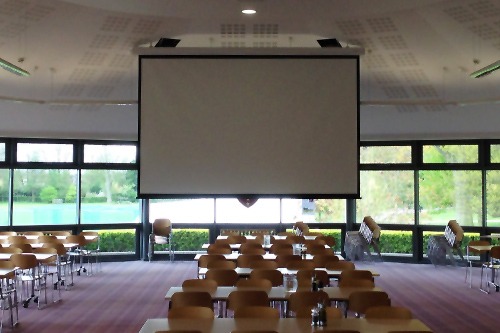School halls have relatively complex audio visual requirements. The large open space is great at eating up sound, making speaker placement vital. The acoustic qualities of the hall also need to be considered to avoid reverberation.
On the visual side, the main concern is a restricted screen view. Simply put, pupils must see the screen no matter where they sit. This is a problem because there is a physical limit to how large a screen can go.
AV for School Halls – Top tips from our experts
Audio
Speakers should surround the entire hall with front, side, and rear-facing speakers so everyone in the hall has clear audio. The speaker wattage defines the power output, and a higher wattage can mean using fewer speakers.
A central amplifier controls unpowered speakers, and the amplifier provides ultimate control over audio and sources. Powered speakers do not need an amp; instead, you control them via a digital device like a laptop.
Visual
Go for the biggest screen possible and double and triple up when needed. One large projector screen is great, but you can add more screens to improve the viewing experience for pupils arranged in wide seating rows.
Lighting is very important. You should have dimmable lighting (not just on or off), and you can also use coloured LED bulbs to reduce blue light. Ceiling lights are ideal because they illuminate the space without blinding the audience.
Television screens are suitable for peppering around school hall walls, but they are never big enough to function as the main screen.
Acoustics
The acoustic qualities of a school hall directly impact the AV experience. Even when a hall is packed with pupils, reverberation can be an issue. One way to reduce reverberation is with acoustic wall panels and panels for the roof.
Bass placement is also important. If you have a dedicated bass, it should be placed on a solid and insulated surface, so it doesn’t rattle.
Cranking up speakers can also unsettle some students. If you have an assembly row for students with sensory issues, the ability to reduce the noise level of speakers in that zone will help provide a safer experience for those students.
Overall
AV for school halls requires careful planning to ensure that students and teachers have the best AV experience. If you throw up a projector, dot some speakers around and hope for the best, you are unlikely to achieve good results.
Here’s a summary of our tips:
- Go for a large projector screen, and don’t be afraid to double up. Wide rows of students may require an additional screen for optimal viewing.
- LED displays (and televisions) are suitable for small meetings and information, but they are not suitable for large assemblies.
- Speakers should be placed across the hall to surround students, and ideally, you should have control over individual speaker zones.
- Acoustic insulation for the school hall walls and roof will eliminate reverberation and improve the overall sound quality of the hall.
If you have any questions, feel free to contact us.



